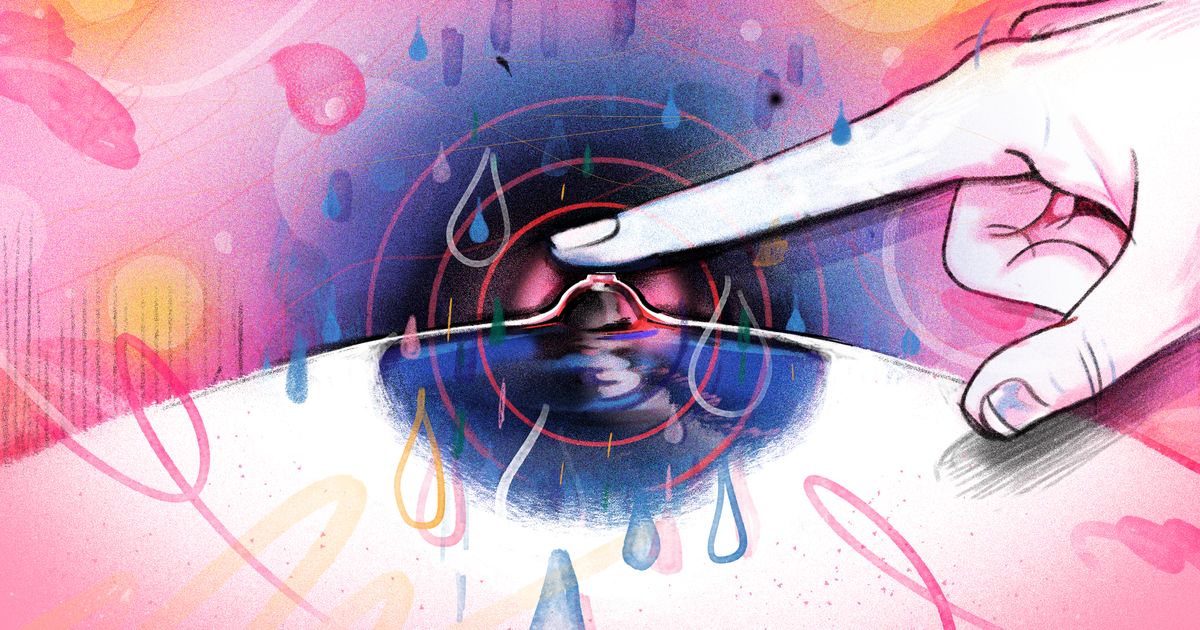Check out more stories from Busted, our series that offers an unfiltered exploration and celebration of our boobs and ourselves during breast cancer awareness month.
Thaovy Van, a 24-year-old who lives in New York City, feels an “intense rush of sadness” coursing through her body whenever her nipples are touched.
It’s “maybe similar to how it feels when you touch your belly button,” she told HuffPost. “But along with the sadness, I definitely feel a mix of anxiety, discomfort and maybe a slight sense of impending doom.”
Van doesn’t remember exactly when she first noticed it but recalls the feelings cropping up when she put on a bra or shirt that grazed her nipples.
“I just brushed it off as being ticklish or generally uncomfortable in that area,” she said.
In August, Van posted about this strange sensation on TikTok with the audio, “something horrible is happening inside of me, and I don’t know why.” She overlayed the video with text that said: “When my nips get touched, and I suddenly feel this uncontrollable sense of sadness.” She posted it, not expecting it would be something many people would relate to.
Her TikTok has since amassed more than 4.6 million views and over 12,000 comments, many from users expressing their shock that this is a thing that other people experience, too.
“Before [I posted], I definitely thought I was the odd one out,” Van said.
Based on the sheer number of views and comments on Van’s TikTok and others like it, it’s clear she’s not alone. The internet has named this seemingly common but under-discussed phenomenon “sad nipple syndrome.” It’s unclear how prevalent it is, but it seems more common among women than men.
People with this condition say they feel a fleeting rush of negative emotion when their nipples are touched, whether when they accidentally brush them in the shower, while changing their clothes or when a partner touches them during foreplay.
Those who experience sad nipple syndrome often use similar emotional vocabulary to describe the sensation: homesickness, dread, guilt, sadness, doom and a pit in the stomach come up again and again.
Others on TikTok describe it more poetically as “the same feeling of being at a sleepover for too long,” “like 4 p.m. on a Sunday,” and “longing for someplace that doesn’t seem to exist.”
Sad nipple syndrome has not been researched and many medical professionals say they’ve never even heard of it. So we don’t know much about it beyond the anecdotal reports found online in Reddit threads, viral TikToks and comment sections dedicated to the topic.
Sad nipple syndrome may be related to a condition some breastfeeding women experience called D-MER.
Interestingly, the feelings people with sad nipple syndrome describe are similar to those of lactating mothers with a dysphoric milk-ejection reflex report.
Dysphoric milk-ejection reflex — or D-MER, as it’s called — is a phenomenon in which women experience a brief but intense emotional drop right before milk is released from the breast. The dysphoria (another word for a state of mental discomfort or distress) typically lasts only a few minutes.
Mothers often use words like homesick, depressed, guilty, worried and anxious to describe the sensation. It’s estimated that as many as 9% of breastfeeding women experience it, according to one study.
With D-MER, the wave of negative emotion can occur with direct stimulation of the nipple during nursing or pumping. But it can also happen before a spontaneous letdown when milk is released from the breast without any physical stimulation (e.g., when you hear your baby cry and your breasts start leaking).
Because it’s connected to the milk ejection reflex, D-MER is thought to be a physiological response to breastfeeding rather than a psychological one. When the reflex is stimulated, a hormonal shift is triggered, leading to a rush of negative feelings in some women.
What might be causing these phenomena?
Research on D-MER is limited, so its exact mechanism is still unknown. But lactation experts Alia Macrina Heise and Diane Wiessinger — who coined the term D-MER — believe it could be related to an abrupt drop in the hormone dopamine.
Because sad nipple syndrome hasn’t been researched, we can only speculate what might cause it. Barry Komisaruk, a behavioral neuroscientist and distinguished professor of psychology at Rutgers University, has a theory about the mechanism behind D-MER and sad nipple syndrome. He told HuffPost he believes the two phenomenons are related and may have an evolutionary basis tied to breastfeeding that applies to both lactating and non-lactating people.
First, a bit of background: “The evolutionary adaptive role of nipple stimulation in mammals is to stimulate the ‘milk ejection reflex,’ also known as the ‘milk letdown reflex,’ Komisaruk explained.
Stimulating the nipples triggers the release of oxytocin into the bloodstream. There are oxytocin receptors located in the muscle-like cells of the mammary glands. The circulating oxytocin stimulates the contraction of these cells, which helps physically squeeze the breast milk out of the breast and into the infant’s mouth.
Since most mammals cannot move around while they nurse their young, they must lie down and rest while their babies are suckling. As a result, a neural mechanism has evolved to ensure the mother slows down to remain still and calm while breastfeeding, Komisaruk said.
That mechanism is a “powerful inhibition in the brain,” he said, which turns down activity in the sympathetic nervous system (which is responsible for the fight-or-flight response) so the parasympathetic division (which is accountable for the rest-and-digest response) can take over.
This is important because stress releases adrenaline, which blocks the action of oxytocin on milk letdown. So reducing adrenaline “enables the milk ejection reflex to proceed unimpeded,” Komisaruk explained.
The inhibition in the brain promotes the mother’s physical stillness and generates a mental quieting, Komisaruk said. Individuals who experience D-MER or sad nipple syndrome may perceive this mental quieting as depression, darkness or homesickness because they associate the down feeling with sad events. These feelings may be amplified for them, but what they’re feeling isn’t abnormal, Komisaruk said.
And even though the process described above facilitates breastfeeding, Komisaruk said: “the hard-wired neural system in the brain for this crucial reproductive process” evidently can happen in women who are not lactating — and even in men, too.
“There are some cultures in which the men actually become ‘wet nurses’ and can produce milk that feeds the infants,” he added.
Finding out that other people experience sad nipple syndrome can be validating.
Lucy H., a 24-year-old from Melbourne, posted her own TikTok in response to Van’s video, explaining how relieved she felt to know she wasn’t alone in feeling this way.
“I truly cannot describe how validating it is to see this video and know that so many other people feel this way as well,” she said in her TikTok.
She told HuffPost she remembers first experiencing sad nipple syndrome as a kid when she would dry off after a shower.
“I didn’t realize what it was, so I associated it with being naked,” Lucy said.
For years, she never told anyone about it.
“I just avoided deliberately or accidentally touching my nipples as the sensation was so uncomfortable and overwhelming,” she said.
After posting her video, she was heartened to read all of the comments from people who felt similarly sharing their experiences and other information they found online.
Further research will hopefully illuminate the science behind this phenomenon one day. But in the meantime, just knowing so many others are in the same boat is comforting. And that can make something uncomfortable much more bearable.
“One of the wonderful things about social media is women being able to share experiences and feelings that are taboo or frowned upon in society,” Lucy said. “So often I see videos like this that make me feel less alone and like I’m part of a greater global community of women. The sadness of having my nipples touched is a horrible feeling, but it helps to know other women feel it, too.”


